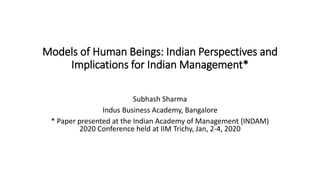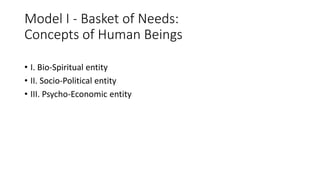Models of Human Beings: Indian Perspectives and Implications for Indian Management
- 1. Models of Human Beings: Indian Perspectives and Implications for Indian Management* Subhash Sharma Indus Business Academy, Bangalore * Paper presented at the Indian Academy of Management {INDAM) 2020 Conference held at IIM Trichy, Jan, 2-4, 2020
- 2. Roots of Indian Perspectives • Purushartha Theory • Panchkosha • Triguna concept
- 3. Four Indian Models of Human Beings • Four Indian Models of Human Beings • 1. Basket of Needs • 2. Modes of Thinking • 3. Hierarchy of Deeds/ Actions • 4. Envelopes of Consciousness
- 4. Model I - Basket of Needs: Concepts of Human Beings • I. Bio-Spiritual entity • II. Socio-Political entity • III. Psycho-Economic entity
- 5. Basket of Needs Economic/Wealth/ Money Political/ Power needs Social needs/ Relationship needs Biological needs Identity & Self actualization needs/ Psychological needs Self realization need/ Happiness need/ Enlightenment need/ Spiritual needs (Western Windows Eastern Doors, Subhash Sharma, 1996, p. 96)
- 6. Basket Model and Social Discourse Adam SmithAbraham Lincoln Max Weber Darwin Aurobindo Maslow
- 7. Model II - Modes of Thinking • Five modes of thinking/ Pentagon Model • I. Power acquisition • II. Calculative and acquisitive • III. Knowledge acquisition • IV. Concern for others • V. Liberation (from domination/ oppression) (Western Windows Eastern Doors, 1996, p. 15)
- 8. Modes of Thinking & Motives Mode of Thinking Driving Force/Motive I. Power acquisition Power II. Calculative & acquisitive Money III. Knowledge acquisition Intellectual pursuits IV. Concern for others Empathy V. Liberation Change/ Transformation (Western Windows Eastern Doors, Subhash Sharma, 1996, p. 15)
- 9. Self Rating on Modes of Thinking • Mode of Thinking Low High 1 2 3 4 5 • 1. Power acquisition • 2. Calculative • 3. Knowledge acquisition • 4. Concern for others • 5. Liberation (from domination/ oppression)
- 10. Spider Diagram CalculativePower acquisition Liberation From domination Concern for others Knowledge acquisition 3 4 5 1 2 5 4 3 2 1 An Illustrative Spider Diagram
- 11. Model III - Hierarchy of Deeds • Typology of Deeds/Actions: Tamas, Rajas, Sattava • Three types of Deeds – 3 G Model • G3: Graceful deeds/actions • G2: Goodness • G1: Greed • (Hierarchy of Deeds: Western Windows Eastern Doors, Subhash Sharma, 1996, p. 75) G1 G3 G2
- 12. Model IV- Envelopes of Consciousness HB (Human Being) = (PE) Q * EQ * IQ * SQ * DQ PE : Physical Energy EQ: Emotional Quotient IQ: Intelligence Quotient SQ: Spiritual Quotient DQ: Divinity Quotient
- 13. Expressions of Self in Market, Society and Corporation • Expressions of Basket of Needs, Modes of Thinking, Hierarchy of Deeds and Envelopes of Consciousness in Market, Society and Organizations • Implications for Management in general and Indian Management in particular













